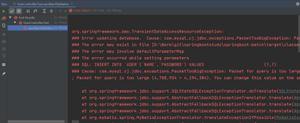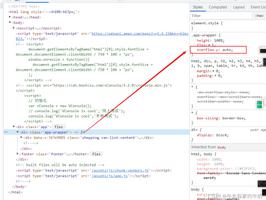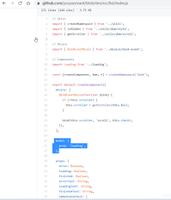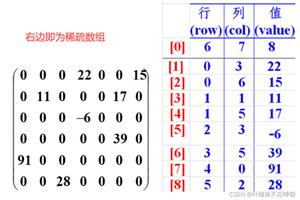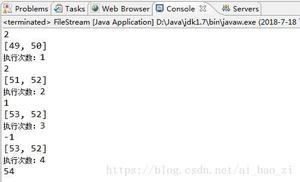java中list的用法和实例讲解
目录:
list中添加,获取,删除元素;
list中是否包含某个元素;
list中根据索引将元素数值改变(替换);
list中查看(判断)元素的索引;
根据元素索引位置进行的判断;
利用list中索引位置重新生成一个新的list(截取集合);
对比两个list中的所有元素;
判断list是否为空;
返回Iterator集合对象;
将集合转换为字符串;
将集合转换为数组;
集合类型转换;
去重复;
备注:内容中代码具有关联性。
1.list中添加,获取,删除元素;
添加方法是:.add(e); 获取方法是:.get(index); 删除方法是:.remove(index); 按照索引删除; .remove(Object o); 按照元素内容删除;
List<String> person=new ArrayList<>();
person.add("jackie"); //索引为0 //.add(e)
person.add("peter"); //索引为1
person.add("annie"); //索引为2
person.add("martin"); //索引为3
person.add("marry"); //索引为4
person.remove(3); //.remove(index)
person.remove("marry"); //.remove(Object o)
String per="";
per=person.get(1);
System.out.println(per); ////.get(index)
for (int i = 0; i < person.size(); i++) {
System.out.println(person.get(i)); //.get(index)
}
2.list中是否包含某个元素;
方法:.contains(Object o); 返回true或者false
List<String> fruits=new ArrayList<>();
fruits.add("苹果");
fruits.add("香蕉");
fruits.add("桃子");
//for循环遍历list
for (int i = 0; i < fruits.size(); i++) {
System.out.println(fruits.get(i));
}
String appleString="苹果";
//true or false
System.out.println("fruits中是否包含苹果:"+fruits.contains(appleString));
if (fruits.contains(appleString)) {
System.out.println("我喜欢吃苹果");
}else {
System.out.println("我不开心");
}
3.list中根据索引将元素数值改变(替换);
注意 .set(index, element); 和 .add(index, element); 的不同;
String a="白龙马", b="沙和尚", c="八戒", d="唐僧", e="悟空";
List<String> people=new ArrayList<>();
people.add(a);
people.add(b);
people.add(c);
people.set(0, d); //.set(index, element); //将d唐僧放到list中索引为0的位置,替换a白龙马
people.add(1, e); //.add(index, element); //将e悟空放到list中索引为1的位置,原来位置的b沙和尚后移一位
//增强for循环遍历list
for(String str:people){
System.out.println(str);
}
4.list中查看(判断)元素的索引;
注意:.indexOf(); 和 lastIndexOf()的不同;
List<String> names=new ArrayList<>();
names.add("刘备"); //索引为0
names.add("关羽"); //索引为1
names.add("张飞"); //索引为2
names.add("刘备"); //索引为3
names.add("张飞"); //索引为4
System.out.println(names.indexOf("刘备"));
System.out.println(names.lastIndexOf("刘备"));
System.out.println(names.indexOf("张飞"));
System.out.println(names.lastIndexOf("张飞"));
5.根据元素索引位置进行的判断;
if (names.indexOf("刘备")==0) {
System.out.println("刘备在这里");
}else if (names.lastIndexOf("刘备")==3) {
System.out.println("刘备在那里");
}else {
System.out.println("刘备到底在哪里?");
}
6.利用list中索引位置重新生成一个新的list(截取集合);
方法: .subList(fromIndex, toIndex); .size() ; 该方法得到list中的元素数的和
List<String> phone=new ArrayList<>();
phone.add("三星"); //索引为0
phone.add("苹果"); //索引为1
phone.add("锤子"); //索引为2
phone.add("华为"); //索引为3
phone.add("小米"); //索引为4
//原list进行遍历
for(String pho:phone){
System.out.println(pho);
}
//生成新list
phone=phone.subList(1, 4); //.subList(fromIndex, toIndex) //利用索引1-4的对象重新生成一个list,但是不包含索引为4的元素,4-1=3
for (int i = 0; i < phone.size(); i++) { // phone.size() 该方法得到list中的元素数的和
System.out.println("新的list包含的元素是"+phone.get(i));
}
7.对比两个list中的所有元素;
//两个相等对象的equals方法一定为true, 但两个hashcode相等的对象不一定是相等的对象
//1.<br>if (person.equals(fruits)) {
System.out.println("两个list中的所有元素相同");
}else {
System.out.println("两个list中的所有元素不一样");
}
//2.
if (person.hashCode()==fruits.hashCode()) {
System.out.println("我们相同");
}else {
System.out.println("我们不一样");
}
8.判断list是否为空;
//空则返回true,非空则返回false
if (person.isEmpty()) {
System.out.println("空的");
}else {
System.out.println("不是空的");
}
9.返回Iterator集合对象;
System.out.println("返回Iterator集合对象:"+person.iterator());
10.将集合转换为字符串;
String liString="";
liString=person.toString();
System.out.println("将集合转换为字符串:"+liString);
11.将集合转换为数组;
System.out.println("将集合转换为数组:"+person.toArray());
12.集合类型转换;
//1.默认类型
List<Object> listsStrings=new ArrayList<>();
for (int i = 0; i < person.size(); i++) {
listsStrings.add(person.get(i));
}
//2.指定类型
List<StringBuffer> lst=new ArrayList<>();
for(String string:person){
lst.add(StringBuffer(string));
}
13.去重复;
List<String> lst1=new ArrayList<>();
lst1.add("aa");
lst1.add("dd");
lst1.add("ss");
lst1.add("aa");
lst1.add("ss");
//方法 1.
for (int i = 0; i <lst1.size()-1; i++) {
for (int j = lst1.size()-1; j >i; j--) {
if (lst1.get(j).equals(lst1.get(i))) {
lst1.remove(j);
}
}
}
System.out.println(lst1);
//方法 2.
List<String> lst2=new ArrayList<>();
for (String s:lst1) {
if (Collections.frequency(lst2, s)<1) {
lst2.add(s);
}
}
System.out.println(lst2);
附完整代码
package MyTest01;
import java.util.ArrayList;
import java.util.List;
public class ListTest01 {
public static void main(String[] args) {
//list中添加,获取,删除元素
List<String> person=new ArrayList<>();
person.add("jackie"); //索引为0 //.add(e)
person.add("peter"); //索引为1
person.add("annie"); //索引为2
person.add("martin"); //索引为3
person.add("marry"); //索引为4
person.remove(3); //.remove(index)
person.remove("marry"); //.remove(Object o)
String per="";
per=person.get(1);
System.out.println(per); ////.get(index)
for (int i = 0; i < person.size(); i++) {
System.out.println(person.get(i)); //.get(index)
}
//list总是否包含某个元素
List<String> fruits=new ArrayList<>();
fruits.add("苹果");
fruits.add("香蕉");
fruits.add("桃子");
//for循环遍历list
for (int i = 0; i < fruits.size(); i++) {
System.out.println(fruits.get(i));
}
String appleString="苹果";
//true or false
System.out.println("fruits中是否包含苹果:"+fruits.contains(appleString));
if (fruits.contains(appleString)) {
System.out.println("我喜欢吃苹果");
}else {
System.out.println("我不开心");
}
//list中根据索引将元素数值改变(替换)
String a="白龙马", b="沙和尚", c="八戒", d="唐僧", e="悟空";
List<String> people=new ArrayList<>();
people.add(a);
people.add(b);
people.add(c);
people.set(0, d); //.set(index, element) //将d唐僧放到list中索引为0的位置,替换a白龙马
people.add(1, e); //.add(index, element); //将e悟空放到list中索引为1的位置,原来位置的b沙和尚后移一位
//增强for循环遍历list
for(String str:people){
System.out.println(str);
}
//list中查看(判断)元素的索引
List<String> names=new ArrayList<>();
names.add("刘备"); //索引为0
names.add("关羽"); //索引为1
names.add("张飞"); //索引为2
names.add("刘备"); //索引为3
names.add("张飞"); //索引为4
System.out.println(names.indexOf("刘备"));
System.out.println(names.lastIndexOf("刘备"));
System.out.println(names.indexOf("张飞"));
System.out.println(names.lastIndexOf("张飞"));
//根据元素索引位置进行的判断
if (names.indexOf("刘备")==0) {
System.out.println("刘备在这里");
}else if (names.lastIndexOf("刘备")==3) {
System.out.println("刘备在那里");
}else {
System.out.println("刘备到底在哪里?");
}
//利用list中索引位置重新生成一个新的list(截取集合)
List<String> phone=new ArrayList<>();
phone.add("三星"); //索引为0
phone.add("苹果"); //索引为1
phone.add("锤子"); //索引为2
phone.add("华为"); //索引为3
phone.add("小米"); //索引为4
//原list进行遍历
for(String pho:phone){
System.out.println(pho);
}
//生成新list
phone=phone.subList(1, 4); //.subList(fromIndex, toIndex) //利用索引1-4的对象重新生成一个list,但是不包含索引为4的元素,4-1=3
for (int i = 0; i < phone.size(); i++) { // phone.size() 该方法得到list中的元素数的和
System.out.println("新的list包含的元素是"+phone.get(i));
}
//对比两个list中的所有元素
//两个相等对象的equals方法一定为true, 但两个hashcode相等的对象不一定是相等的对象
if (person.equals(fruits)) {
System.out.println("两个list中的所有元素相同");
}else {
System.out.println("两个list中的所有元素不一样");
}
if (person.hashCode()==fruits.hashCode()) {
System.out.println("我们相同");
}else {
System.out.println("我们不一样");
}
//判断list是否为空
//空则返回true,非空则返回false
if (person.isEmpty()) {
System.out.println("空的");
}else {
System.out.println("不是空的");
}
//返回Iterator集合对象
System.out.println("返回Iterator集合对象:"+person.iterator());
//将集合转换为字符串
String liString="";
liString=person.toString();
System.out.println("将集合转换为字符串:"+liString);
//将集合转换为数组,默认类型
System.out.println("将集合转换为数组:"+person.toArray());
////将集合转换为指定类型(友好的处理)
//1.默认类型
List<Object> listsStrings=new ArrayList<>();
for (int i = 0; i < person.size(); i++) {
listsStrings.add(person.get(i));
}
//2.指定类型
List<StringBuffer> lst=new ArrayList<>();
for(String string:person){
lst.add(StringBuffer(string));
}
}
private static StringBuffer StringBuffer(String string) {
return null;
}
}
到此这篇关于java中list的用法和实例讲解的文章就介绍到这了,更多相关java list内容请搜索以前的文章或继续浏览下面的相关文章希望大家以后多多支持!
以上是 java中list的用法和实例讲解 的全部内容, 来源链接: utcz.com/z/352816.html

